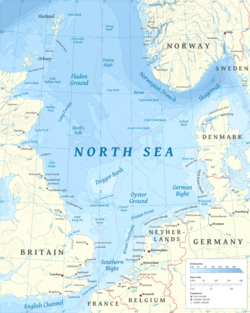Battle of Dogger Bank (1916) facts for kids
Quick facts for kids Battle of Dogger Bank |
|||||||
|---|---|---|---|---|---|---|---|
| Part of the First World War | |||||||
 |
|||||||
|
|||||||
| Belligerents | |||||||
| Commanders and leaders | |||||||
| Strength | |||||||
| 4 sloops | 25 torpedo boats | ||||||
| Casualties and losses | |||||||
| 1 sloop sunk 56 dead 14 captured |
none | ||||||
The Battle of Dogger Bank was a sea battle that happened on 10 February 1916. It was fought between the German Navy (called the Kaiserliche Marine) and the British Royal Navy during the First World War.
Three groups of German torpedo boats sailed into the North Sea. They met the British 10th Sloop Flotilla near Dogger Bank. A torpedo boat is a small, fast warship that carries torpedoes.
The German ships attacked the British ships. They thought the British ships were powerful cruisers, but they were actually minesweeping sloops. A sloop is a smaller warship, and a minesweeper clears dangerous underwater mines.
The British ships knew they had fewer and weaker guns. They tried to escape. During the chase, the British sloop HMS Arabis was sunk. The rest of the British ships got away.
Later, as a British cruiser group returned to port, the light cruiser HMS Arethusa hit an underwater mine. It ran aground (got stuck) and broke in half. The Germans won this battle, but they made their victory sound bigger. They claimed they had sunk two cruisers.
Contents
Why the Battle Happened
At the start of 1916, Germany's navy was led by Admiral Reinhard Scheer. He wanted to find ways to fight against Britain's strong navy. Britain had set up a naval blockade around Germany. This stopped food and supplies from reaching Germany.
Admiral Scheer knew his main fleet, the High Seas Fleet, could not easily beat the British Grand Fleet. But he hoped to make the British tired of the war. So, German raids in the North Sea became more common.
British Alert and German Sailings
On February 9, the British Admiralty (the navy's command center) warned that the Germans might be planning an attack. British ships were ordered to sail south.
The alert was later called off. But the next day, it was found that German light cruisers and destroyers had sailed west.
Ships Involved
The Germans sent 25 ships for this mission. These were from three torpedo-boat groups. Their leader was Kommodore Johannes Hartog. They wanted to stop Allied (British and French) shipping.
The only British ships in the area were the 10th Sloop Flotilla. This group included HMS Arabis, Poppy, Buttercup, and Alyssum.
Each of these sloops was armed with two 4.7-inch guns and two small anti-aircraft guns. They were not strong enough to fight against the large number of German torpedo boats.
The Battle Begins
HMS Arabis and the other three sloops were clearing a safe path east of Dogger Bank. That is when many German torpedo boats saw them.
At first, the Germans were not sure what kind of ships the British had. The new Arabis-class sloops looked different. The Germans thought they were much more powerful cruisers. But they decided to attack anyway because they had many more ships.
When the attack began, the British ships tried to escape. They wanted to reach the safety of the coast.
Sinking of HMS Arabis
HMS Poppy, Buttercup, and Alyssum managed to get away. But HMS Arabis was not so lucky. Three German torpedo boats caught and attacked it.
After fighting off that first attack, Arabis was attacked again by six more German boats. They sank Arabis with torpedoes. The Germans rescued Lieutenant-Commander Hallowell-Carew and 13 other crew members from Arabis.
After the Battle
Losses and Claims
The only ship lost in the battle was HMS Arabis. Fifty-six of its crew members were killed. Fourteen were captured by the Germans, including the captain. The German destroyers had only minor damage.
For his brave actions, Arabis' captain, Lieutenant Commander Robert Raymond Hallowell-Carew, received a special medal.
Even though they had only sunk a minesweeping sloop, the Germans claimed a bigger victory. They said they had fought a group of four new cruisers and sunk two of them. The British Admiralty quickly corrected this. They said that only the 10th Sloop Flotilla was involved and no cruisers had been sunk.
The Fate of HMS Arethusa
After the battle, other British fleets sailed into the North Sea. They searched for German ships but gave up on February 11. It was clear that the German torpedo boats had already returned to their base.
As the light cruiser HMS Arethusa was returning, it hit a German mine. This mine had been placed by a German submarine the night before. Six men died in the explosion.
The ship began to sink. Several attempts to pull the ship to safety failed because the sea was rough. Arethusa was pushed onto a sandbank and broke in two.

